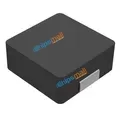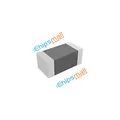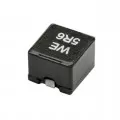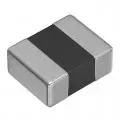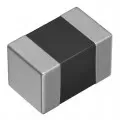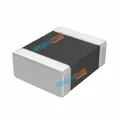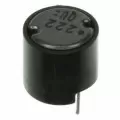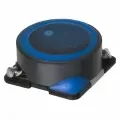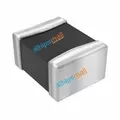OUTLINE:
Can You Tell The Differences Between Different Inductor Types
 206
206Inductors are critical electronic devices that can store energy within a magnetic field generated when an electrical current passes through. They find wide applications in power supplies, transformers, filters, and radio frequency circuits. These devices make inductors very important in laying down the characteristics of an electrical circuit; this may be noise reduction, improvement in terms of power, or facilitation of wireless communication.
Despite the deceptively simple structure which the inductor takes normally more than a coil, the actual nature of the inductor can be very different concerning design, core material, and intended application. These variations, in turn, create several inductor types, each optimized for a particular function such as handling high currents, working at high frequencies, or optimizing energy losses. The proper selection of an inductor type can enhance circuit performance greatly, while the wrong choice can lead to inefficiency or even failure.
In this article, we will consider several inductor variants by breaking down their special properties, methods of construction, and optimal applications. From designing a low-pass filter to working on an RF antenna, or even optimizing a power converter, there's the need to understand the strengths and limitations various inductors pose for efficient, reliable systems. At the end of this tutorial, you should know the best way to go about selecting the appropriate types of inductors for your particular application.
Types of Inductors
1. Air Core Inductors
Air core inductors use air as the core material and no ferromagnetic material inside the coil. Therefore, they are used in those applications that require a very high frequency of operation combined with minimum energy loss, such as RF circuits and wireless communication. Air core inductors have low inductance and high-frequency stability but generally require more turns of wire to achieve desired values of inductance. Hence, they turn out to be larger and less efficient concerning the space factor.
Pros:
· Stable at high frequencies
· No core saturation, as there is no magnetic core.
· No energy losses to hysteresis or eddy currents
· Ideal for RF and wireless communication circuits
Cons:
· Low inductance values relative to magnetic core inductors
· High inductance requires a larger size and more turns of wire.
· Less effective in low-frequency applications
2. Iron Core Inductors
Iron core inductors rely on a ferromagnetic iron core that increases the value of inductance by concentrating the magnetic field. Common applications include low-frequency inductive circuits, like power supplies and audio equipment; one could also say that transformers fall under this category. Iron core inductors do exhibit higher inductance than air core versions but may face the same drawbacks: core saturation, energy loss through hysteresis and eddy currents, and inefficiency at higher frequencies.
Pros:
· Since iron has magnetic properties, inductance is high.
· Efficient for low-frequency applications - power supplies and transformers
· Economical in high-power applications
Cons:
· Prone to core saturation at high currents
· Very large energy losses through hysteresis and eddy currents
· Poor performance at high frequencies due to core losses.
3. Ferrite core inductors
Ferrite core inductors are made up of a ceramic compound that uses iron oxide and other metals such as zinc or manganese. Applications of these include power supplies, filters, and RF circuits, which are very high frequency. Ferrite cores have high magnetic permeability with very low core losses and, hence, are ideal to operate at very high frequencies. They are smaller and more efficient compared to inductors with iron cores, but may still face the problem of core saturation at a pretty high current.
Pros:
· Excellent in high-frequency applications
· Low core losses at high frequency: eddy currents and hysteresis
· Compact and lightweight
· High magnetic permeability allows high inductance in a small package.
Cons:
· Prone to core saturation at high currents
· Low performance for high-current applications when compared to powdered iron core
4. Toroidal Inductors
Inductors of toroidal shapes are wound on ring-shaped or doughnut-shaped cores made usually of iron powder or ferrite. This toroid shape allows the magnetic field to be contained within the core, reducing EMI in nearby components. Toroidal inductors have wide applications in power supplies, audio equipment, and RF circuits. They are more efficient, having a high inductance value and low energy losses, but unlike inductors of other construction types, they may be more difficult to produce and wind.
Pros:
· Reduced electromagnetic interference due to a bounded magnetic field.
· High efficiency and low energy losses.
· Compact and space-saving design provides high inductance.
· Ideal for Power supply, audio, and RF applications
Cons:
· more difficult and costly to produce
· Winding the coil is often challenging as compared to the inductor variant.
5. Laminated Core Inductors
Laminated-core inductors use a core made of thin layers or laminations of metal-usually some form of silicon steel-to reduce energy losses due to eddy currents. The lamination is in place to give an effective rise in efficiency and a reduction of core loss in low-frequency, high-power applications like transformers and power supplies. While the laminated core inductors do an excellent job in handling high currents, they fall behind when the frequencies become higher since the size and weight of the laminated core restrict performance.
Pros:
· The laminated core design means less loss from eddy currents.
· High current capacity for use in transformers and power supplies.
· Good for low-frequency, high-power applications
Cons:
· Larger and heavier, hence less suitable for compact designs.
· Poor performance due to core losses and size increases at higher frequencies.
· Lower efficiency in high-frequency applications
6. Inductors of Powdered Iron Core
The iron core inductors help in reducing the eddy current loss because they are made of iron particles bound with an insulating material. These inductors are quite stable and can hold high saturation current capacity, which is very suitable for high current power supply applications such as DC-to-DC converters and switching regulators. Powdered iron cores have medium magnetic permeability and are more resistant to saturation compared to ferrite cores but are less effective at higher frequencies.
Pros:
· High saturation current capacity, suitable for high-current applications DC-DC converters, etc.
· Stable performance in the middle frequencies.
· Lower risk of core saturation compared to ferrite core inductors
· Moderate cost and availability
Cons:
· Higher core losses at high frequencies compared to ferrite cores
· Lower inductance values than ferrite cores for the same size
· Less effective in high-frequency applications
7. Multilayer Inductors
Multilayer inductors have several layers of conductive material, separated by insulating layers. They find a wide application in SMT compact class electronic equipment, including smartphones and tablets, due to the small-sized packages and high-frequency performance of the former. They can offer high inductance in a small form factor but usually have lower current ratings and higher DC resistance than other forms.
Pros:
· Small in size, used for small-size electronic gadgets like smartphones and tablets.
· High inductance in a small footprint
· Suitable for high-frequency applications, like RF circuits
· Common in surface mount technology (SMT)
Cons:
· Lower current rating compared to larger inductors
· Higher DC resistance; therefore more loss of power in certain applications
· Generally more expensive given their size
8. Variable Inductors
Variable inductors change the value of inductance either by changing the core position or by changing the number of turns in the coil. These inductors come into tuning circuits of radio receivers and oscillators, where fine-tuning is needed in the inductance to get the exact frequency response. Variable inductors allow for applications that require precise control of inductance and may be more complicated and thus more costly than fixed inductors.
Pros:
· Adjustable inductance allows for fine-tuning in some applications like radio receivers and oscillators.
· Ideal for applications requiring critical control of frequency response
· Flexibility in tuning without component replacement
Cons:
· More complex and costly than fixed inductors
· Larger and more mechanically complicated
· Limited to use outside tuning circuits or applications that require variable control.
FAQs
1. What is the role of an inductor in an electronic circuit?
Inductors can store energy in their magnetic field when current passes through them. The general uses include filtering, storing energy, and matching impedance while finding applications in oscillators and transformers, as well. An inductor may be used to smooth voltage spikes, filter out high-frequency noise, or stabilize current flow in power supplies.
2. What is the difference between air core and iron core inductors?
Air Core Inductors: These use air as a core material and provide lower inductance but with very stable performance at high frequencies. They are suited for RF circuits and applications involving high frequency. Iron Core Inductors: The iron core is made up of a ferromagnetic material, high values of inductance are obtained but may also have core saturation and energy losses by hysteresis and eddy currents at higher frequencies. They are more suitable for low-frequency applications like power supplies and transformers.
3. Why are Ferrite core inductors preferred for high-frequency applications?
Because these inductors exhibit high magnetic permeability with low core loss, hence they are efficient in handling high-frequency energy with low dissipation of energy. Their lightweight and compact design also allows their use in high-frequency circuits such as RF filters and power supply switching regulators.
4. What are toroidal inductors used for?
These inductors have a core that is doughnut-shaped. They are also used in power supplies, RF, and audio since they are small in size; thus, they offer high efficiency and reliability in applications involving high power and low noise because the magnetic field can be kept within the core.
5. What is the advantage of using inductors with laminated cores?
Laminated core inductors use thin layers of metal that are laminated together to reduce eddy current losses. Such a configuration allows them to be effective at low-frequency, high-power applications such as transformers and industrial power supplies where the signal current is large. Because of their larger size, and greater losses, laminated cores cannot be used very effectively in high-frequency applications.
Conclusion
Inductors form vital parts of any electronic circuit, ranging from air core inductors to ferrite core inductors, serving different applications under different conditions. The peculiar properties of each of the air core inductors that serve well in high-frequency RF applications to ferrite core inductors efficiently in power supplies must be understood in detail for their correct application. Engineers will be able to have their circuitry running efficiently with minimum losses in energy and interference by considering factors such as frequency, current handling, size, and core material.
Whether it's related to designs with power converters, signal filters, or tuning circuits, the choice of inductor type is important when it comes to system reliability and performance. From air core to iron core to ferrite core, anything one can think of, several different inductor types have advantages for designs to best fit specific needs.

Disclaimer: The views and opinions expressed by individual authors or forum participants on this website do not represent the views and opinions of Chipsmall, nor do they represent Chipsmall's official policy.

share this blog to:


